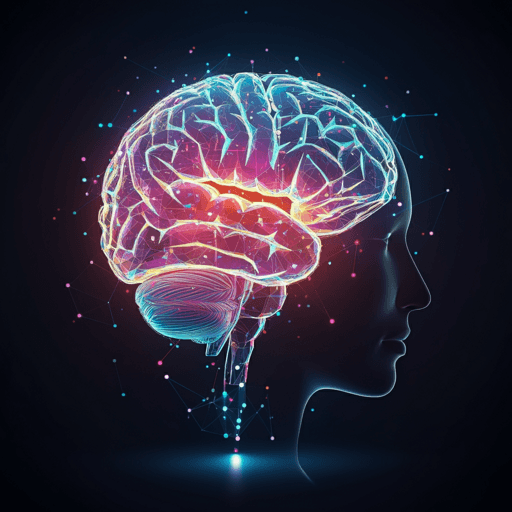
Medicine and Health
Higher-order connectomics of human brain function reveals local topological signatures of task decoding, individual identification, and behavior
A. Santoro, F. Battiston, et al.
This study shows higher-order approaches greatly enhance decoding between tasks, improve identification of unimodal and transmodal functional subsystems, and strengthen associations between brain activity and behavior, revealing unexplored structures hidden from pairwise models. Research conducted by Andrea Santoro, Federico Battiston, Maxime Lucas, Giovanni Petri, and Enrico Amico.
~3 min • Beginner • English
Introduction
The study addresses whether reconstructed higher-order interactions (involving three or more brain regions) provide advantages over traditional pairwise functional connectivity (FC) approaches in fMRI analysis. While network neuroscience typically models brain function via pairwise dependencies, mounting evidence at micro- and macro-scales suggests the importance of higher-order interactions (HOIs). The authors hypothesize that HOI-based methods, especially local topological indicators, can better decode task states, improve individual identification (functional fingerprinting), and strengthen brain–behavior associations compared to pairwise approaches. Using Human Connectome Project data, they apply a recent topological framework to reconstruct instantaneous higher-order co-fluctuations and evaluate performance along spatial (global vs local) and complexity (lower- vs higher-order) axes.
Literature Review
Prior work established the connectome concept and FC as central tools in network neuroscience. However, FC assumes pairwise interactions, potentially missing information present only in joint distributions. Evidence from neuronal recordings in animals demonstrates group-level events, and recent non-invasive human neuroimaging studies have begun inferring HOIs via information theory (e.g., multivariate mutual information, partial information decomposition) and computational topology (simplicial complexes, persistent homology). Edge-centric approaches expanded beyond nodes, revealing overlapping communities and dynamic connectivity at fine timescales, yet their higher-order potential in fMRI remained underexplored. Early applications showed HOI biomarkers distinguishing consciousness states and aging effects. Machine learning using temporal HOI statistics improved classification in non-neural contexts over pairwise measures. Methods like ICA provide complementary multivariate decompositions but differ conceptually from HOI inference. These strands motivate testing whether inferred HOIs outperform traditional methods for decoding tasks, fingerprinting, and behavior associations in fMRI.
Methodology
Data: fMRI from 100 unrelated HCP subjects (Release Q3), with resting-state runs (REST1, REST2; LR and RL phase encoding) and seven task fMRI paradigms (gambling, relational, social, working memory, motor, language, emotion). Minimally preprocessed HCP data were further processed: GLM regression (detrending/quadratic trend removal; motion regressors and derivatives; white matter and CSF regressors and derivatives; global signal regression and derivative), bandpass filtering (0.01–0.15 Hz), parcellation to 119 nodes (Schaefer 100 cortical regions + 16 subcortical + 3 cerebellar from HCP Atlas_ROI2), and z-scoring of node time series.
Higher-order co-fluctuation reconstruction: For each order k (up to k=2), define k-order time series as element-wise products of k+1 z-scored node signals, standardized across time to facilitate cross-order comparability. Apply sign remapping to emphasize perfectly coherent group interactions (all-positive or all-negative mapped as positive, discordant mixtures mapped negative). At each time t, encode all edges (k=1) and triangles (k=2) into a weighted simplicial complex K, assigning weights w_ij(t) and w_ijk(t) from the standardized co-fluctuation signals.
Topological analysis: Build a filtration by sorting weights descending, enforcing simplicial closure; triangles violating closure (with weaker edges than triangle weight) are flagged and stored as violating triangles Δ with their weights. Define global hyper-coherence as the fraction of violating coherent triangles among all coherent triangles. Compute persistent homology (H1) across the filtration to characterize 1D cycles (birth b_g, death d_g); define hyper-complexity as the sliced Wasserstein distance between the H1 persistence diagram and the empty diagram, quantifying topological complexity of coherent/decoherent landscapes. Construct the homological scaffold (frequency scaffold): a weighted graph where edges are weighted by the number of cycles they participate in, highlighting links acting as local bridges in the HO landscape.
Local indicators and lower-order baselines: Four local temporal signals considered: BOLD node signals, edge time series, triangle time series (violating triangles list/weights), and scaffold activity (weights from homological scaffold). For each method, construct recurrence plots by concatenating 300 volumes of rest data with seven task blocks (rest blocks excluded), computing time–time Pearson correlations between time points, binarizing at the 95th percentile, and detecting communities via the Louvain algorithm. Compute element-centric similarity (ECS) between detected communities and ground-truth task/rest segmentation to quantify task decoding performance.
Functional brain fingerprinting: For two resting sessions (REST_1_LR, REST_2_LR), compute static connectivity features per method: node FC (correlations among node BOLD), eFC (correlations among edge time series), average violating triangle weights (triangles), and average scaffold weights (scaffold). Construct identifiability matrices comparing test/retest connectivity per subject using Pearson correlations; differential identifiability (I_diff) is the difference between average self-similarity (I_self) and average inter-subject similarity (I_others). Evaluate both whole-brain connections and local subnetworks by restricting to connections involving nodes within specific resting-state networks (VIS, SM, DA, VA, L, FP, DMN, SC).
Brain–behavior association: Perform Partial Least Square Correlation (PLSC) between static connectivity values and 10 HCP cognitive domains (episodic memory, executive functions, fluid intelligence, language, processing speed, self-regulation/impulsivity, spatial orientation, sustained visual attention, verbal episodic memory, working memory). When multiple raw scores exist per domain, extract the first principal component. Assess significance via permutation testing (1000 permutations; p<0.05), reliability via bootstrapping (1000 resamples; saliences reliable if |z|>2), and quantify explained covariance by summing squared singular values of significant components normalized by total. For robust estimates, randomly sample 80 of 100 subjects and repeat PLSC 100 times. Also compare Canonical Correlation Analysis (CCA) in supplementary analyses.
Key Findings
Global indicators: Hyper-coherence and hyper-complexity showed remarkably similar values across tasks with no significant differences (all pairwise t-test p-values > 0.1), indicating limited utility for global task decoding.
Local task decoding: Recurrence plot ECS values averaged over 100 subjects increased with higher-order methods, demonstrating superior task discriminability: BOLD ECS ≈ 0.46; edge ECS ≈ 0.73; triangle ECS ≈ 0.76; scaffold ECS ≈ 0.88. Higher-order local indicators (violating triangles and scaffold) more effectively decoded individual tasks and rest blocks compared to lower-order methods.
Functional fingerprinting: Whole-brain identifiability scores across methods were similar (no significant differences). Restricting to local functional networks, the triangles method consistently achieved higher differential identifiability across nearly all networks (VIS, SM, DA, VA, L, FP, DMN, SC), while scaffold scores were consistently <9% (omitted for clarity). Triangle-based nodal strength exhibited high coefficient of variation across subjects, especially in interactions between unimodal (somatosensory, visual) and transmodal (DMN, frontoparietal) systems, indicating subject-specific higher-order patterns.
Brain–behavior associations: Using whole-brain connections, all methods explained similar fractions of covariance (~10–20%). Focusing on local subnetworks, higher-order methods markedly improved explained covariance, with triangles reaching ~80% in somatosensory areas and scaffolds generally outperforming FC/eFC across multiple networks. Cognitive saliences varied across methods and networks, suggesting HOI-based measures capture distinct cognitive dimensions. CCA and additional PLSC robustness analyses corroborated superior local performance of higher-order methods.
Conceptual alignment: Violating triangle activation patterns resembled redundancy-dominated information structures, while the homological scaffold aligned with synergistic contributions identified by multivariate information-theoretic approaches.
Discussion
The findings indicate that global higher-order metrics fail to differentiate task states or improve behavioral associations over pairwise methods, whereas local higher-order indicators provide substantial benefits. Instantaneous topological descriptors of higher-order co-fluctuations capture nuanced, spatially specific coordination that enhances temporal task decoding, individual identification, and brain–behavior associations. This supports the view that pairwise FC predominantly captures redundancy, while synergistic group interactions, reflected in local higher-order structures (e.g., homological scaffold), bear stronger behavioral relevance. The results align with literature on task reconfiguration, emphasizing complex, distributed changes beyond uniform shifts in functional links. Comparisons with multivariate information decomposition suggest complementary roles: triangles (redundancy-like) and scaffolds (synergy-like). The approach inherently incorporates temporal dynamics without reliance on long windows, enabling rich instantaneous scoring options. Overall, embracing higher-order local topology reveals subtle patterns obscured by conventional bivariate analyses, offering a refined window into centralized and distributed cognitive processing.
Conclusion
The study demonstrates that local higher-order topological measures derived from fMRI time series outperform traditional pairwise approaches in three key applications: task decoding, functional brain fingerprinting, and brain–behavior association. While global higher-order indicators provide limited added value, local indicators—violating triangles and homological scaffolds—offer superior temporal discrimination, subject identifiability within functional subsystems, and stronger, more diverse behavioral relevance. These results advocate for adopting higher-order frameworks to unlock latent structure in functional brain data. Future research should reduce computational demands by reconstructing targeted subsets of k-order interactions, extend beyond k=2, and integrate complementary techniques (e.g., Takens embeddings, spectral and geometric methods) to elucidate causal relationships and further enhance interpretability and predictive power.
Limitations
Computational complexity scales as O(N^k); reconstructing co-fluctuations up to order k is costly compared to node/edge methods. Current implementation (k=2) requires ~5 minutes per HCP subject on a high-end workstation (Ryzen Threadripper 3970, 24 cores). Direct measurements of true group interactions are rarely available, necessitating statistical inference. The study limits higher-order structures to triangles (k=2); exploring higher k and selective reconstruction strategies is needed to balance performance and tractability.
Related Publications
Explore these studies to deepen your understanding of the subject.







